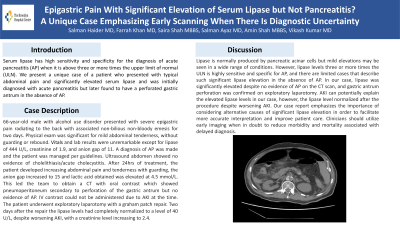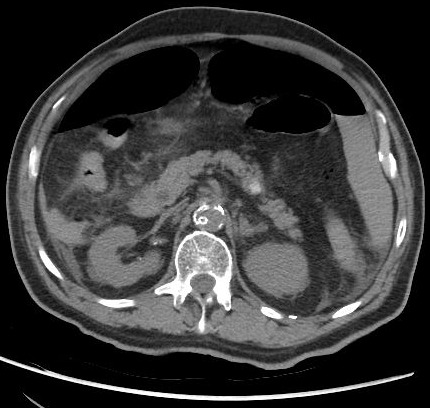Back


Poster Session D - Tuesday Morning
Category: Biliary/Pancreas
D0044 - Epigastric Pain With Significant Elevation of Serum Lipase but Not Pancreatitis? A Unique Case Emphasizing Early Scanning When There Is Diagnostic Uncertainty
Tuesday, October 25, 2022
10:00 AM – 12:00 PM ET
Location: Crown Ballroom

Has Audio
.jpg)
Salman Haider, MD
The Brooklyn Hospital Center
Brooklyn, NY
Presenting Author(s)
Salman Haider, MD1, Farrah Khan, MD1, Saira Shah, MBBS2, Salman Ayaz, MD1, Amin Shah, MBBS3, Vikash Kumar, MD1
1The Brooklyn Hospital Center, Brooklyn, NY; 2Brooklyn, NY; 3Brookyln, NY
Introduction: Serum lipase has high sensitivity and specificity for the diagnosis of acute pancreatitis (AP) when it is above three or more times the upper limit of normal (ULN). We present a unique case of a patient who presented with typical abdominal pain and significantly elevated serum lipase and was initially diagnosed with acute pancreatitis but later found to have a perforated gastric antrum in the absence of AP.
Case Description/Methods: A 66-year-old male with alcohol use disorder presented with severe epigastric pain radiating to the back with associated non-bilious non-bloody emesis for two days. Physical exam was significant for mild abdominal tenderness, without guarding or rebound. His vitals were normal and lab results were unremarkable except for lipase of 444 U/L, creatinine of 1.9, and anion gap of 11. A diagnosis of AP was made and the patient was managed per guidelines. Ultrasound abdomen showed no evidence of cholelithiasis or acute cholecystitis. After 24hrs of treatment, the patient developed increasing abdominal pain and tenderness with guarding, the anion gap increased to 15 and lactic acid obtained was elevated at 4.5 mmol/L. This led the team to obtain a CT with oral contrast which showed pneumoperitoneum secondary to perforation of the gastric antrum but no evidence of AP. IV contrast could not be administered due to AKI at the time. The patient underwent exploratory laparotomy with a graham patch repair. Two days after the repair the lipase levels had completely normalized to a level of 40 U/L, despite worsening AKI, with a creatinine level increasing to 2.4.
Discussion: Lipase is normally produced by pancreatic acinar cells but mild elevations may be seen in a wide range of conditions. However, lipase levels three or more times the ULN is highly sensitive and specific for AP, and there are limited cases that describe such significant lipase elevation in the absence of AP. In our case, lipase was significantly elevated despite no evidence of AP on the CT scan, and gastric antrum perforation was confirmed on exploratory laparotomy. AKI can potentially explain the elevated lipase levels in our case, however, the lipase level normalized after the procedure despite worsening AKI. Our case report emphasizes the importance of considering alternative causes of significant lipase elevation in order to facilitate more accurate interpretation and improve patient care. Clinicians should utilize early imaging when in doubt to reduce morbidity and mortality associated with delayed diagnosis.

Disclosures:
Salman Haider, MD1, Farrah Khan, MD1, Saira Shah, MBBS2, Salman Ayaz, MD1, Amin Shah, MBBS3, Vikash Kumar, MD1. D0044 - Epigastric Pain With Significant Elevation of Serum Lipase but Not Pancreatitis? A Unique Case Emphasizing Early Scanning When There Is Diagnostic Uncertainty, ACG 2022 Annual Scientific Meeting Abstracts. Charlotte, NC: American College of Gastroenterology.
1The Brooklyn Hospital Center, Brooklyn, NY; 2Brooklyn, NY; 3Brookyln, NY
Introduction: Serum lipase has high sensitivity and specificity for the diagnosis of acute pancreatitis (AP) when it is above three or more times the upper limit of normal (ULN). We present a unique case of a patient who presented with typical abdominal pain and significantly elevated serum lipase and was initially diagnosed with acute pancreatitis but later found to have a perforated gastric antrum in the absence of AP.
Case Description/Methods: A 66-year-old male with alcohol use disorder presented with severe epigastric pain radiating to the back with associated non-bilious non-bloody emesis for two days. Physical exam was significant for mild abdominal tenderness, without guarding or rebound. His vitals were normal and lab results were unremarkable except for lipase of 444 U/L, creatinine of 1.9, and anion gap of 11. A diagnosis of AP was made and the patient was managed per guidelines. Ultrasound abdomen showed no evidence of cholelithiasis or acute cholecystitis. After 24hrs of treatment, the patient developed increasing abdominal pain and tenderness with guarding, the anion gap increased to 15 and lactic acid obtained was elevated at 4.5 mmol/L. This led the team to obtain a CT with oral contrast which showed pneumoperitoneum secondary to perforation of the gastric antrum but no evidence of AP. IV contrast could not be administered due to AKI at the time. The patient underwent exploratory laparotomy with a graham patch repair. Two days after the repair the lipase levels had completely normalized to a level of 40 U/L, despite worsening AKI, with a creatinine level increasing to 2.4.
Discussion: Lipase is normally produced by pancreatic acinar cells but mild elevations may be seen in a wide range of conditions. However, lipase levels three or more times the ULN is highly sensitive and specific for AP, and there are limited cases that describe such significant lipase elevation in the absence of AP. In our case, lipase was significantly elevated despite no evidence of AP on the CT scan, and gastric antrum perforation was confirmed on exploratory laparotomy. AKI can potentially explain the elevated lipase levels in our case, however, the lipase level normalized after the procedure despite worsening AKI. Our case report emphasizes the importance of considering alternative causes of significant lipase elevation in order to facilitate more accurate interpretation and improve patient care. Clinicians should utilize early imaging when in doubt to reduce morbidity and mortality associated with delayed diagnosis.

Figure: CT abdomen shows contrast extravasation and a large amount of pneumoperitoneum
Disclosures:
Salman Haider indicated no relevant financial relationships.
Farrah Khan indicated no relevant financial relationships.
Saira Shah indicated no relevant financial relationships.
Salman Ayaz indicated no relevant financial relationships.
Amin Shah indicated no relevant financial relationships.
Vikash Kumar indicated no relevant financial relationships.
Salman Haider, MD1, Farrah Khan, MD1, Saira Shah, MBBS2, Salman Ayaz, MD1, Amin Shah, MBBS3, Vikash Kumar, MD1. D0044 - Epigastric Pain With Significant Elevation of Serum Lipase but Not Pancreatitis? A Unique Case Emphasizing Early Scanning When There Is Diagnostic Uncertainty, ACG 2022 Annual Scientific Meeting Abstracts. Charlotte, NC: American College of Gastroenterology.
